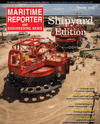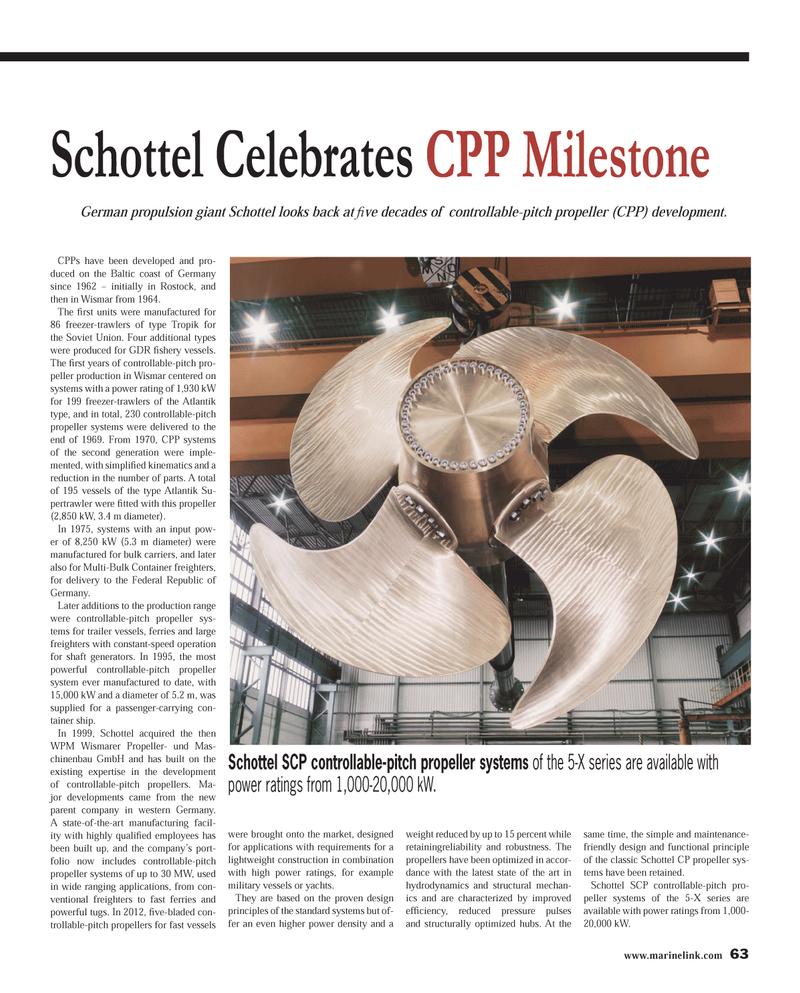
Page 63: of Maritime Reporter Magazine (August 2013)
Shipyard Edition
Read this page in Pdf, Flash or Html5 edition of August 2013 Maritime Reporter Magazine
www.marinelink.com 63CPPs have been developed and pro-duced on the Baltic coast of Germany since 1962 ? initially in Rostock, and then in Wismar from 1964. The Þ rst units were manufactured for 86 freezer-trawlers of type Tropik for the Soviet Union. Four additional types were produced for GDR Þ shery vessels. The Þ rst years of controllable-pitch pro-peller production in Wismar centered on systems with a power rating of 1,930 kW for 199 freezer-trawlers of the Atlantik type, and in total, 230 controllable-pitch propeller systems were delivered to the end of 1969. From 1970, CPP systems of the second generation were imple-mented, with simpliÞ ed kinematics and a reduction in the number of parts. A total of 195 vessels of the type Atlantik Su- pertrawler were Þ tted with this propeller (2,850 kW, 3.4 m diameter). In 1975, systems with an input pow-er of 8,250 kW (5.3 m diameter) were manufactured for bulk carriers, and later also for Multi-Bulk Container freighters, for delivery to the Federal Republic of Germany. Later additions to the production range were controllable-pitch propeller sys-tems for trailer vessels, ferries and large freighters with constant-speed operation for shaft generators. In 1995, the most powerful controllable-pitch propeller system ever manufactured to date, with 15,000 kW and a diameter of 5.2 m, was supplied for a passenger-carrying con- tainer ship.In 1999, Schottel acquired the then WPM Wismarer Propeller- und Mas- chinenbau GmbH and has built on the existing expertise in the development of controllable-pitch propellers. Ma-jor developments came from the new parent company in western Germany. A state-of-the-art manufacturing facil- ity with highly qualiÞ ed employees has been built up, and the company?s port- folio now includes controllable-pitch propeller systems of up to 30 MW, used in wide ranging applications, from con-ventional freighters to fast ferries and powerful tugs. In 2012, Þ ve-bladed con- trollable-pitch propellers for fast vessels were brought onto the market, designed for applications with requirements for a lightweight construction in combination with high power ratings, for example military vessels or yachts. They are based on the proven design principles of the standard systems but of-fer an even higher power density and a weight reduced by up to 15 percent while retainingreliability and robustness. The propellers have been optimized in accor- dance with the latest state of the art in hydrodynamics and structural mechan-ics and are characterized by improved efÞ ciency, reduced pressure pulses and structurally optimized hubs. At the same time, the simple and maintenance-friendly design and functional principle of the classic Schottel CP propeller sys- tems have been retained.Schottel SCP controllable-pitch pro- peller systems of the 5-X series are available with power ratings from 1,000-20,000 kW. Schottel Celebrates CPP MilestoneGerman propulsion giant Schottel looks back at Þ ve decades of controllable-pitch propeller (CPP) development. Schottel SCP controllable-pitch propeller systems of the 5-X series are available with power ratings from 1,000-20,000 kW. MR #8 (58-65).indd 63MR #8 (58-65).indd 638/2/2013 8:53:34 AM8/2/2013 8:53:34 AM

 62
62

 64
64
